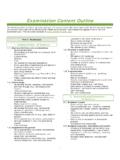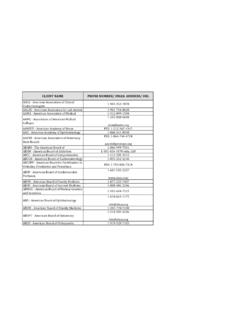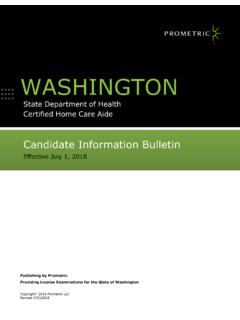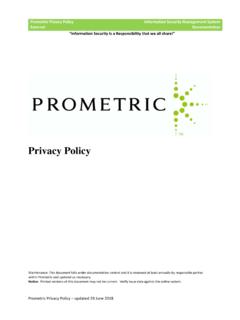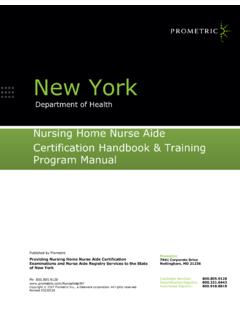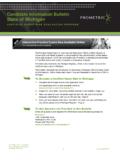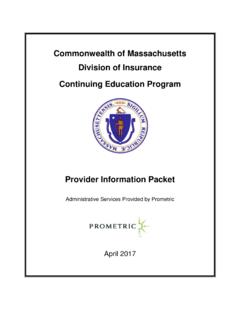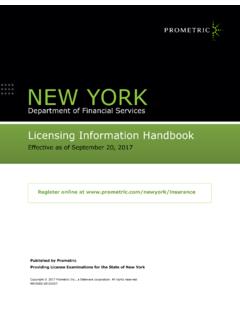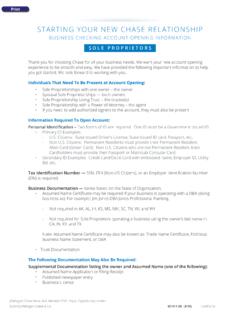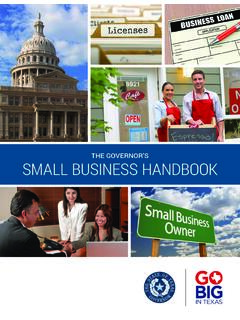Transcription of Domain 1: Business Entities and Considerations 30 Questions
1 Domain 1: Business Entities and Considerations 30 Questions Business Entities -Sole proprietorships -Partnerships and qualified joint ventures (QJV) -Corporations -S corporations -LLCs -Tax-exempt Entities and associations -Entity type default classifications and elections -Employer identification number -Accounting periods (tax year) -Reporting requirements (e. g., Forms W-2, W-4, Form 1099) -Hobby versus Business determination and loss limitations Partnerships -Partnership income, expenses, distributions, and flow-through (e. g., self-employment income) -Family partnerships -Partner's dealings with partnership (e. g., exchange of property, guaranteed payments) -Contribution of property and/or services to a partnership (e. g., partnership's basis, property subject to indebtedness) -Basis of partner's interest -Disposition of partner's interest -Partnership formation (e.)
2 G., partnership agreement, general vs limited partners, capital contributions) -Dissolution of partnership (e. g., sale, death of partner) -Filing requirements, due dates, penalties, and audit notice requirements -Partnership cancellation of debt -Partnership level audit and opt-out Corporations in general -Filing requirements, due dates, and penalties -Earnings and profits -Shareholder dividends, distributions, and recognition requirements -Special deductions and credits (e. g., dividends received deductions, charitable deduction) -Liquidations and stock redemptions -Accumulated earnings tax -Estimated tax payments -Corporate minimum tax credit Forming a corporation -Services rendered to a corporation in return for stock -IRC section 351 exchange -Transfer and/or receipt of money or property in addition to corporate stock -Transfer of property subject to indebtedness -Controlled groups -Closely held corporations S corporations -Requirements to qualify (e.
3 G., qualifying shareholders) -Election procedure -Income, expenses and separately stated items -Treatment of distributions -Shareholder s basis (e. g., loan basis, distributions and losses in excess of basis, services for stock) -Revocation, termination and reinstatement -Debt discharge Domain 2: Business Tax Preparation 37 Questions Business Income -Gross receipts and other income -Cost of goods sold (e. g., inventory practices, expenditures included, uniform capitalization rules) -Net income/loss and at-risk limitations -Cancellation of Business debt Business expenses, deductions and credits -Officers and employees compensation (e. g., deductibility, fringe benefits, rules of family employment, statutory employee, necessary and reasonable) - Business rental deduction, including self-rentals -Depreciation, amortization (start-up and organizational cost), IRC section 179, depletion, bonus depreciation, and correcting errors - Business bad debts - Business travel, meals, and gift expenses -Vehicle use and expenses -Interest expense -Insurance expense -Taxes (e.
4 G., deductibility of taxes, assessments, and penalties; proper treatment of sales taxes paid, excise) -Employment taxes -Casualties, thefts, and condemnations - Qualified Business income(QBI) ( , SSTB, calculations, phase out, UBIA) -Eligibility and deductibility of general Business credits (e. g., disabled access credit, R & D credit, small Business healthcare tax credit, foreign tax credit) -Net operating loss deduction -Home office Business assets -Basis of assets -Disposition of property or assets -Like kind exchange -Converted property -Capitalization and repair regulations (e. g., elections) Analysis of financial records -Proper Business type, the use of classification codes, and year to year comparison -Income statement -Balance sheet (e. g., proofing beginning and ending balances, relationship to income statement and depreciation) -Method of accounting and changes (e.
5 G., accrual, cash, hybrid, Form 3115) -Depreciation recovery (e. g., recapture, IRC sec 280F) -Pass-through activity (e. g., K-1, separately stated items, non-deductible expenses) -Reconciliation of tax versus books (e. g., M-1, M-2, M-3) -Related party activity -Loans to and from owners Advising the Business taxpayer -Reporting and filing obligations (e. g., extended returns and potential penalties, international information returns, Form 1099 series, Form 8300) -Payments and deposit obligations (e. g., employment tax, excise tax) -Record-keeping requirements (e. g., mileage log, accountable plans) -Selection of Business entity (e. g., benefits and detriments) -Comingling (e. g., personal usage of Business accounts, separation of Business and personal accounts) -Advice on accounting methods and procedures (e.
6 G., explanation of requirements) -Transfer of property in or out of the Business -Life cycle of the Business (e. g., formation, dissolution) -Type of industry (e. g., specified service Business owners) -Worker classification ( , independent contractor versus employee, outside sales, full-time versus part-time) -Deductions and credits for tax planning ( , timing of income and expenses, NOL, depreciation versus IRC section 179 versus bonus depreciation) -ACA compliance Domain 3: Specialized Returns and Taxpayers 18 Questions Trust and estate income tax -Trust types (e. g., simple/complex, grantor, irrevocable, tax shelters, foreign) -Distributable net income and accounting income -Exclusions, exemptions, and deductions -Fraudulent trusts -Income (e. g., allocations, corpus versus income) -Separately stated items ( , items reported on the K-1) -Filing requirements, tax years, and penalties Exempt organizations -Qualifying for and maintaining tax-exempt status (e.
7 G., IRC 501(c)) -Applying for IRS tax-exempt status (e. g., Form 1023, Form 1024) -Filing requirements (e. g., Form 990 series) -Unrelated Business taxable income Retirement plans -Employer and employee contributions -Reporting requirements -Plans for self-employed persons (e. g., SEP and SIMPLE) -Prohibited transactions -Qualified and non-qualified plans -Non-discrimination rules Farmers -Farm income ( , livestock, crop insurance proceeds, subsidies, patronage dividends, conservation payments) -Depreciation for farmers -Disaster-area provisions ( , drought, flood, other weather-related conditions) -Farm rental ( , Form 4835) -Farm tax computation ( , Schedule J, Schedule SE, estimated tax) Rental Property -Real estate professional qualifications -Commercial rentals versus residential rentals -Mixed used property/vacation home -Passive loss limitation ( , special $25,000 allowance, MAGI limits) -Rental income ( , deposits, pre-paid rent, not rented for profit)
8 -Rental expenses ( , allocation between personal and rental, repair versus capitalized)

